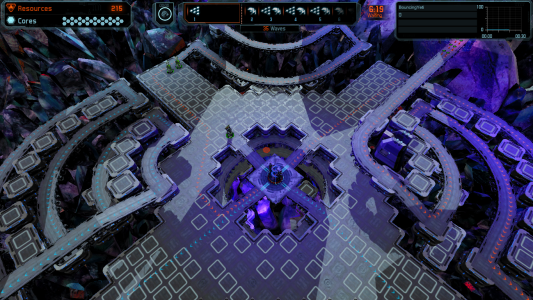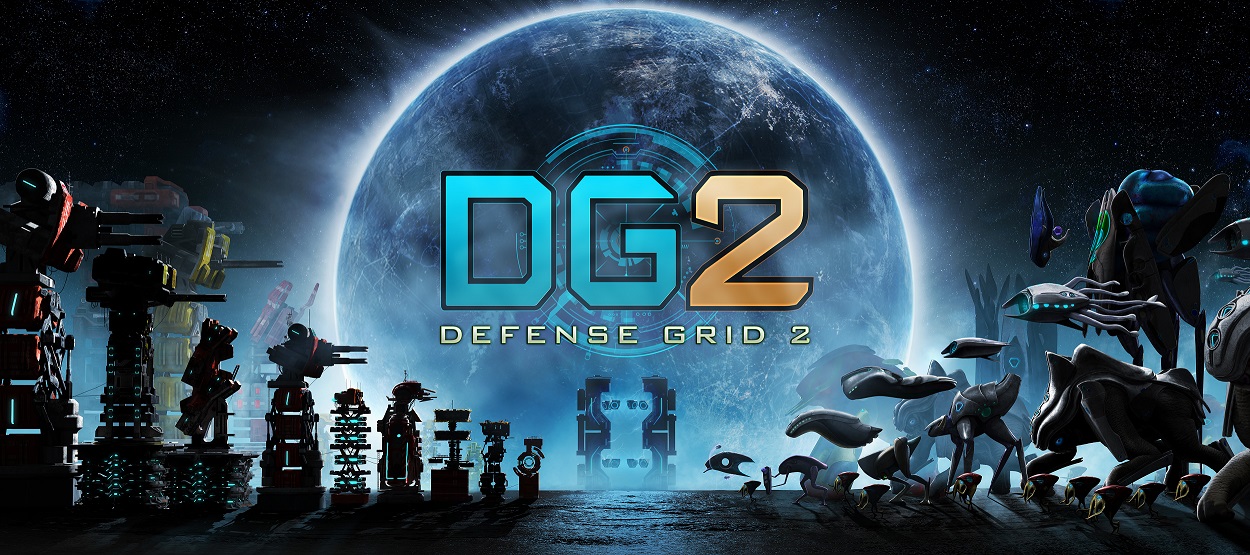Tower Defense games are a classic of the flash game genre but does the charm of the genre transfer to a retail release game? I reviewed Defense Grid 2, the new game PC, PS4, and Xbox One game from Hidden Path Entertainment to find out.
Gameplay
Tower defense games have a simple concept, protect your base from a continuous flow of invaders by constructing towers that have varying capabilities. Defense Grid 2 captures this concept well. The maps are well designed and increase in complexity over the course of the campaign. The spots where you can place towers are clearly indicated and are placed to force you to make difficult decisions about where to place which type of tower.
On the topic of tower types, DG2 boasts 10 different types of towers with varying strengths and weaknesses. Gun towers are medium range all around towers, cannons are slow and powerful, meteors are long ranged, but can’t hit things near them, temporal towers slow nearby enemies, and so on. Each tower can be upgraded during gameplay to be stronger, and completing campaign missions unlocks passive buffs for all towers of a certain type, making them more effective without increasing the price or requiring in game upgrade.
One thing I enjoyed about the game is the ability to reroute the attackers. By strategically placing towers, it is possible to force them to take longer paths, providing more time to try to take them down. Taking advantage of this ability is essential to completing the more difficult missions in the campaign. Another fun feature is the ability to use a special power on a long cooldown. Depending on the commander you select prior to the mission, this ability can range from a suborbital cannon to a buff to nearby towers to a drop of extra resources. This provides some extra interaction beyond deciding where to place and upgrade turrets.
One of the main flaws with the game however, came from the controls. The game’s controls were clear and worked, and I never struggled to do anything when I tried to, but it felt just a little bit clunky. Sometimes the cursor moved just a little differently than I thought it should, or it took an extra click to do something. The PS4 version of the game had controls that felt much smoother than the PC, which is a point in the console version’s favor.

Campaign
The game’s campaign is composed of twenty missions of increasing difficulty. It does a good job of easing players in to the game and making sure to challenge without overwhelming. Unfortunately, the the game’s storyline does not impress as much as the gameplay. I did not particularly enjoy the voice acting or characters and the story was relatively generic science fiction fare. While the campaign mode did need some sort of wrapping to justify the changing maps and landscapes the wrapping provided is nothing spectacular.
On the upside, there is plenty of replayability in the campaign mode. Before you begin a mission you can select different scenarios, such as having a very limited number of resources, not being allowed to fully upgrade your towers, or not being allowed to use gun or cannon towers. This forces you to create new strategies for maps you’ve already conquered.
Graphics and Sound
Defense Grid’s graphics are one of its strong suits. The difference between different types of towers and different types of enemies is very clear, and the fireworks from the towers’ attacks is satisfying. The map backgrounds are also good looking. As mentioned previously, the voice overs for the game are not great, and the sound effects of the different towers sometimes get muddled together. The fact that the game has a relatively small number of phrases that it repeats for events such as a power core returning to your base does not help matters either.
Multiplayer and Custom Content
Unfortunately I was unable to get into a multiplayer game prior to writing this review, but the offerings seem robust with both PvP and Co-Op offerings. You can queue up for a multiplayer match and then begin a campaign game while waiting. Once the game finds a multiplayer game for you, it will save your campaign progress and drop you into the multiplayer game. Once you’re finished you can go back to your campaign mission, picking up from where you left off.
You also have the ability to create and share custom maps via the Steam Workshop, allowing for even more replay value. This feature however, is absent from the console versions, which limits you to squeezing as much gameplay as you can out of the campaign.
Conclusion
In all, Defense Grid 2 is a solid offering but suffers from a poor story, poor voice acting, and controls that feel just a bit clunky. The price tag of $24.99 is also a bit steep, given the wide availability of free tower defense games online. If you absolutely love the genre and want to design and share your own maps then this might be the right game for you, but if you aren’t a tower defense fanatic, I’d think before making the purchase.

